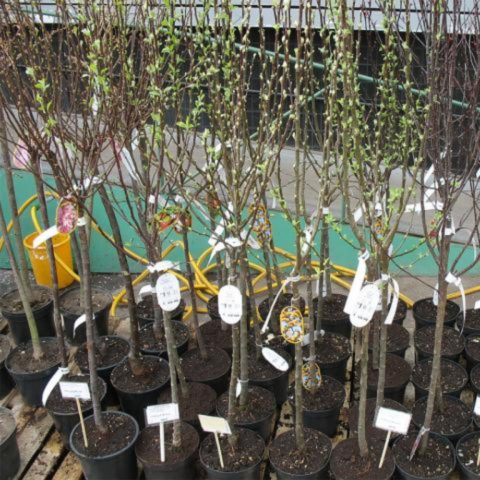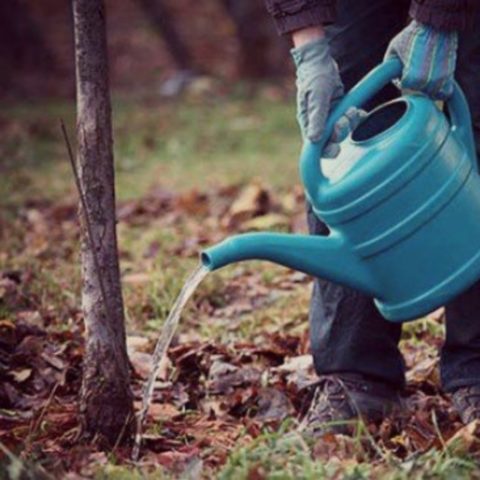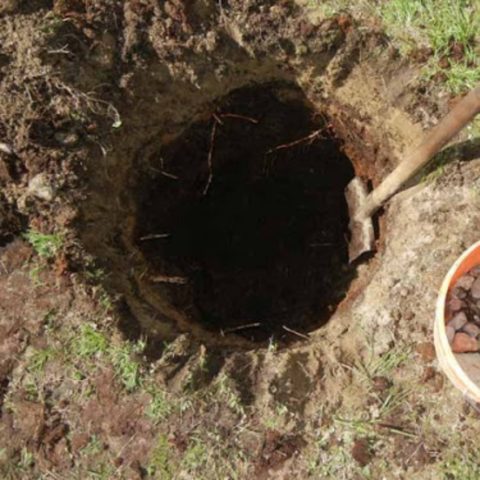Content
- 1 History of selection
- 2 Description of the variety
- 3 Characteristics
- 3.1 Drought resistance
- 3.2 Frost resistance of plum Tent
- 3.3 Pollinators of cherry plum Tent
- 3.4 Is it possible to pollinate with Tsarskaya cherry plum?
- 3.5 Flowering period and ripening time
- 3.6 Productivity, fruiting
- 3.7 Area of application of fruits
- 3.8 Resistance to diseases and pests
- 3.9 Advantages and disadvantages
- 4 Planting and caring for cherry plum Tent
- 5 Diseases and pests, methods of control and prevention
- 6 Conclusion
- 7 Reviews of cherry plum variety Shater
With the development of hybrid cherry plum, the popularity of this crop has increased significantly among gardeners. This is explained by its ability to grow in any climatic conditions, rapid adaptation to a new place, stable yield and high taste of the fruit. One of these species is the Shater variety. Choosing from all the variety, you can’t help but pay attention to it. But before you finally make a decision, you need to study the description of the Shater cherry plum variety in order to understand its strengths and weaknesses.
History of selection
This species was obtained artificially at the Crimean experimental breeding station. The founder of the Shater variety is Eremin Gennady Viktorovich, its director.The basis of the species was the Chinese-American plum Fibing, which was crossed with an unknown type of cherry plum. The result was so successful that it was separated into a separate variety.
In 1991, tests were started to confirm the main characteristics of the Shater cherry plum (photo below). And after their completion, this variety was included in the State Register in 1995. The species is recommended for cultivation in the Central and North Caucasus regions.

Cherry plum Shater can grow in one place for more than 30 years
Description of the variety
This species is characterized by low growth vigor, so the height of an adult tree does not exceed 2.5-3.0 m. The crown of the Tent cherry plum is flat, dense with slightly drooping branches. The main trunk of the tree is smooth and of medium thickness. The bark is gray-brown. Cherry plum Tent forms shoots with a diameter of 2 to 7 mm. On the sunny side they have a reddish-brown tint of medium intensity.
The leaves of the cherry plum Tent are directed upward when blooming, and when they reach their maximum size, they take a horizontal position. The length of the plates is up to 6 cm, their width is about 3.7 cm, the shape is oval-oblong. The apex of the leaves is strongly pointed. The surface is wrinkled, rich green in color. There is no edge on the upper side, but only along the main and side veins on the reverse side. The edge of the plates is double-crown, the degree of waviness is average. The petioles of the cherry plum Shater leaves are quite long, about 11-14 cm and they are 1.2 mm thick.
Flowering for this variety begins in mid-April. During this period, 2 simple flowers with five white petals bloom from medium-sized green buds. Their diameter does not exceed 1.4-1.5 cm. The average number of stamens in each is about 24 pieces.The anthers of the Tent cherry plum are round, yellow, and slightly curved. They are slightly longer than the stigma of the pistil. The calyx is bell-shaped and smooth. The pistil is up to 9 mm long, slightly curved.
The stigma is round in shape, the ovary is bare. The sepals of flowers are bent from the pistil and have no edge. They are green in color and oval. The peduncle is thickened, short, 6 to 8 mm long.
The fruits of the Shater cherry plum are large, about 4.1 cm in diameter, and broadly ovoid in shape. The average weight of each is about 38 g. The main color of the skin is yellow-red, the outer skin is solid, purple in color. There is an average number of subcutaneous points, they are yellow.
The pulp is medium density and grainy, yellow-green in color. Cherry plum Shater has a pleasant sweetish taste with a small amount of sourness and a weak aroma. The skin of the fruit is thick and easily separated from the pulp. It is slightly noticeable when eaten. Inside each fruit there is a slightly rough stone, 2.1 cm long and 1.2 cm wide. It is difficult to separate from the pulp even when the fruit is fully ripe.

When cutting the Shater cherry plum fruit, the flesh darkens slightly
Characteristics
Before choosing this variety, you need to first study its characteristics. This will allow us to assess the degree of productivity of the Shater cherry plum and the possibility of growing it on a personal plot, depending on climatic conditions.
Drought resistance
This hybrid plum can tolerate a lack of moisture for a short period. In case of prolonged drought, the tree needs regular watering. This is especially true during the period of ovary and fruit ripening.
Frost resistance of plum Tent
The tree does not suffer from temperatures dropping to -25 degrees. Therefore, the Shater cherry plum is classified as a frost-resistant species. And even if the shoots freeze, it quickly recovers. Therefore, its productivity does not decrease against this background.
Pollinators of cherry plum Tent
This hybrid plum variety is self-sterile. Therefore, to obtain a stable high yield, it is necessary to plant other types of cherry plum with the same flowering period on the site, which will promote cross-pollination.
The following varieties can be used in this capacity:
- Pavlovskaya Yellow;
- Pchelnikovskaya;
- Comet;
- Sun;
- Lodva.
Is it possible to pollinate with Tsarskaya cherry plum?
This variety is not suitable for pollinating the hybrid Tent plum, as it is a species with a medium flowering period. Cherry plum Tsarskaya forms buds 10-14 days later. In addition, the frost resistance of this species is much lower, so both varieties cannot always be grown in the same area.
Flowering period and ripening time
Cherry plum Tent begins to form buds in mid-April. And by the end of this month all the flowers will bloom. The duration of the period, subject to favorable conditions, is 10 days. Fruit ripening in Shater cherry plum occurs after 3 months. The first harvest can be harvested in late July-early August.
Productivity, fruiting
This variety begins to bear fruit 3-4 years after planting. The harvest volume from 1 adult Shater cherry plum tree is about 40 kg. This is considered a good result compared to other types.
Area of application of fruits
Cherry plum Tent is one of the universal species. Its fruits have a high taste and are therefore ideal for fresh consumption. Also, the thick skin and medium density of the pulp allow this variety to be processed and used for preparing winter preparations.

During heat treatment, the consistency of the fruit is preserved
This hybrid plum can be used to prepare:
- compote;
- jam;
- jam;
- juice;
- adjika;
- ketchup.
Resistance to diseases and pests
This hybrid plum variety is resistant to diseases and pests. But to maintain its natural immunity at a high level, it is recommended to carry out preventive treatment annually in the spring.
Advantages and disadvantages
Cherry Cherry Tent has certain strengths and weaknesses. Therefore, you need to familiarize yourself with them in order to get a complete picture of this variety and understand how critical its shortcomings are.

Cherry plum fruits Shater can be stored for 10 days without loss of taste.
Main advantages:
- early fruit ripening;
- high productivity;
- versatility of application;
- excellent taste;
- small height of the tree, which makes it easier to care for;
- immunity to diseases and pests;
- high frost resistance;
- excellent presentation.
The disadvantages include:
- extended fruiting period;
- incomplete separation of the bone;
- needs pollinators.
Planting and caring for cherry plum Tent
In order for a seedling of this hybrid plum variety to fully grow and develop, it is necessary to plant it taking into account the requirements of the crop.At the same time, it is important not only to choose the right place, but also to observe the optimal timing, and you should also take into account what crops you can grow Shater cherry plum nearby.
Recommended timing
Planting a seedling of this variety should be done in the spring before the buds open. In the southern regions, the optimal period for this is the end of March or the beginning of the next month, and in the central regions - mid or late April.
Choosing a suitable location
For a hybrid plum, you should choose a sunny area, protected from strong gusty winds. Therefore, it is recommended to plant Shater cherry plum on the southern or eastern side of the site.
This crop is undemanding to the composition of the soil, so it can be grown even in heavy clay soil if you initially add peat and sand to it. The groundwater level in the area must be at least 1.5 m. Although cherry plum is a moisture-loving crop, it does not tolerate prolonged stagnation of moisture in the soil and may eventually die.
What crops can and cannot be planted next to cherry plum
For the seedling to grow fully, it is necessary to take into account the possible proximity. You cannot plant the Shater cherry plum variety next to the following trees:
- Apple tree;
- Walnut;
- cherry;
- cherries;
- pear.
The hybrid plum gets along best with other types of crops, including barberry, honeysuckle, and sloe.
Selection and preparation of planting material
For planting, you should choose one- and two-year-old seedlings obtained by cuttings or from shoots.They are able to quickly recover if they freeze in winter.

The seedling for planting should not show signs of the beginning of the growing season
When purchasing, you should pay attention to the bark to avoid damage. The root system should consist of 5-6 well-developed flexible shoots without broken or overdried tips.
Landing algorithm
Planting cherry plum Shater can be done by a gardener even without many years of experience. This procedure is carried out according to the standard scheme. It is important to remember that to get a good hybrid plum harvest, you need to plant at least 2 pollinators.
The planting hole should be prepared 2 weeks before planting. Its size should be 60 by 60 cm. Place a layer of broken brick 10 cm thick on the bottom. And fill the remaining 2/3 of the volume with a soil mixture of turf, peat, sand, and humus in equal quantities. You should also additionally add 200 g of superphosphate, 100 g of potassium sulfate and 1 tbsp. wood ash. Mix everything thoroughly with the soil and then pour it into the planting hole.
Algorithm of actions when landing:
- Make a small mound of soil in the center of the hole.
- Place a cherry plum seedling “Tent” on it, straighten the roots.
- Place a wooden support 1.0-1.2 m high nearby.
- Water generously and wait for the moisture to be absorbed.
- Cover the roots with soil and fill any voids.
- Compact the soil surface at the base of the seedling and trample it with your feet.
- Tie to a support.
- Water generously.
The next day, lay mulch at the base of the tree from peat or humus 3 cm thick. This will retain moisture in the soil and prevent the roots from drying out.
Subsequent care of the crop
Caring for the Shater cherry plum is not difficult. Watering is carried out 2-3 times a month in the absence of seasonal precipitation. During hot periods, the soil at the base of the cherry plum tree should be irrigated once every 10 days, soaking the soil up to 30 cm.
Feeding the tree must begin at the age of three, since before that the plant will consume the nutrients that were added during planting. In early spring, organic matter should be used, and during flowering and fruit formation, phosphorus-potassium mineral mixtures should be used.
Cherry plum Tent does not require formative pruning. It is only recommended to carry out sanitary cleaning of the crown from thickening shoots, as well as from damaged and broken ones. Sometimes you need to pinch the tops of branches to enhance the growth of side shoots.
Before winter, it is recommended to water the Tent cherry plum abundantly at the rate of 6-10 buckets of water per 1 tree, depending on the age. To insulate the root system, lay mulch from humus or peat in a layer of 10-15 cm. If there are wounds on the trunk, treat them with a special solution. To do this, you will need to add 100 g of wood ash, lime and 150 g of copper sulfate to 5 liters of water.

Before wintering, cherry plums need to be watered only in the absence of rain.
Diseases and pests, methods of control and prevention
For prevention purposes, in early spring, Shater cherry plum should be treated with Bordeaux mixture or copper sulfate. You also need to whitewash the tree trunk and skeletal branches with lime. It is recommended to re-treat the crown after flowering using urea in the proportion of 500 g of product per 10 liters of water.
Conclusion
A detailed description of the Shater cherry plum variety will allow every gardener to evaluate the advantages and disadvantages of this species.The information also makes it possible to compare it with other hybrid plums and choose the most suitable option, depending on the climatic conditions of the region.











